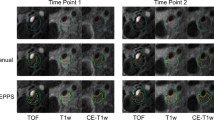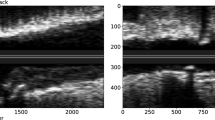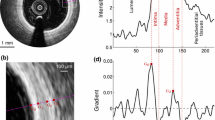Abstract
A machine learning (ML) algorithm for automatic segmentation of intravascular ultrasound was previously validated. It has the potential to improve efficiency, accuracy and precision of coronary vessel segmentation compared to manual segmentation by interventional cardiology experts. The aim of this study is to compare the performance of human readers to the machine and against the readings from a Core Laboratory. This is a post-hoc, cross-sectional analysis of the IBIS-4 study. Forty frames were randomly selected and analyzed by 10 readers of varying expertise two separate times, 1 week apart. Their measurements of lumen, vessel, plaque areas, and plaque burden were performed in an offline software. Among humans, the intra-observer variability was not statistically significant. For the total 80 frames, inter-observer variability between human readers, the ML algorithm and Core Laboratory for lumen area, vessel area, plaque area and plaque burden were not statistically different. For lumen area, however, relative differences between the human readers and the Core Lab ranged from 0.26 to 12.61%. For vessel area, they ranged from 1.25 to 9.54%. Efficiency between the ML algorithm and the readers differed notably. Humans spent 47 min on average to complete the analyses, while the ML algorithm took on average less than 1 min. The overall lumen, vessel and plaque means analyzed by humans and the proposed ML algorithm are similar to those of the Core Lab. Machines, however, are more time efficient. It is warranted to consider use of the ML algorithm in clinical practice.




Similar content being viewed by others
Abbreviations
- CAD:
-
Coronary artery disease
- CL:
-
Core Laboratory
- GT:
-
Ground truth
- IVUS:
-
Intravascular ultrasound
- MACE:
-
Major adverse cardiac event
- MFCNN:
-
Multi-frame convolutional neural network
- MLA:
-
Minimum Lumen Area
- ML:
-
Machine learning
- PAV:
-
Percent atheroma volume
- PCI:
-
Percutaneous coronary intervention
References
Kotecha T, Rakhit RD (2016) Acute coronary syndromes. Clin Med (Lond) 16:s43–s48
Garcia-Garcia HM, Costa MA, Serruys PW (2010) Imaging of coronary atherosclerosis: intravascular ultrasound. Eur Heart J 31:2456–2469
Neumann F-J, Sousa-Uva M, Ahlsson A, Alfonso F, Banning AP, Benedetto U, Byrne RA, Collet J-P, Falk V, Head SJ, Jüni P, Kastrati A, Koller A, Kristensen SD, Niebauer J, Richter DJ, Seferović PM, Sibbing D, Stefanini GG, Windecker S, Yadav R, Zembala MO, ESC Scientific Document Group (2018) ESC/EACTS guidelines on myocardial revascularization. Eur Heart J 2019(40):87–165
Steinvil A, Zhang Y-J, Lee SY, Pang S, Waksman R, Chen S-L, Garcia-Garcia HM (2016) Intravascular ultrasound-guided drug-eluting stent implantation: an updated meta-analysis of randomized control trials and observational studies. Int J Cardiol 216:133–139
Mentias A, Sarrazin MV, Saad M, Panaich S, Kapadia S, Horwitz PA, Girotra S (2020) Long-term outcomes of coronary stenting with and without use of intravascular ultrasound. JACC Cardiovasc Interv 13:1880–1890
Ziemer PGP, Bulant CA, Orlando JI, Maso Talou GD, Álvarez LAM, Guedes Bezerra C, Lemos PA, García-García HM, Blanco PJ (2020) Automated lumen segmentation using multi-frame convolutional neural networks in intravascular ultrasound datasets. Eur Heart J Digit Health 1:75–82
Katouzian A, Angelini ED, Carlier SG, Suri JS, Navab N, Laine AF (2012) A state-of-the-art review on segmentation algorithms in intravascular ultrasound (IVUS) images. IEEE Trans Inf Technol Biomed 16:823–834
Cho H, Kang S-J, Min H-S, Lee J-G, Kim W-J, Kang SH, Kang D-Y, Lee PH, Ahn J-M, Park D-W, Lee S-W, Kim Y-H, Lee CW, Park S-W, Park S-J (2021) Intravascular ultrasound-based deep learning for plaque characterization in coronary artery disease. Atherosclerosis 324:69–75
Lee J-G, Ko J, Hae H, Kang S-J, Kang D-Y, Lee PH, Ahn J-M, Park D-W, Lee S-W, Kim Y-H, Lee CW, Park S-W, Park S-J (2020) Intravascular ultrasound-based machine learning for predicting fractional flow reserve in intermediate coronary artery lesions. Atherosclerosis 292:171–177
Li K, Tong J, Zhu X, Xia S (2021) Automatic lumen border detection in IVUS images using deep learning model and handcrafted features. Ultrason Imaging 43:59–73
Räber L, Taniwaki M, Zaugg S, Kelbæk H, Roffi M, Holmvang L, Noble S, Pedrazzini G, Moschovitis A, Lüscher TF, Matter CM, Serruys PW, Jüni P, Garcia-Garcia HM, Windecker S, for the IBIS 4 (Integrated Biomarkers and Imaging Study-4) Trial Investigators (NCT00962416) (2015) Effect of high-intensity statin therapy on atherosclerosis in non-infarct-related coronary arteries (IBIS-4): a serial intravascular ultrasonography study. Eur Heart J 36:490–500
Blanco PJ, Ziemer PGP, Bulant CA, Ueki Y, Bass R, Räber L, Lemos PA, García-García HM (2021) Fully automated lumen and vessel contour segmentation in intravascular ultrasound datasets. Med Image Anal 75:102262
Maso Talou GD, Larrabide I, Blanco PJ, Bezerra CG, Lemos PA, Feijoo RA (2015) Improving cardiac phase extraction in IVUS studies by integration of gating methods. IEEE Trans Biomed Eng 62:2867–2877
Jensen LO, Thayssen P, Pedersen KE, Stender S, Haghfelt T (2004) Low variation and high reproducibility in plaque volume with intravascular ultrasound. Int J Cardiol 97:463–469
Blessing E, Hausmann D, Sturm M, Wolpers H-G, Amende I, Mügge A (1999) Intravascular ultrasound and stent implantation: intraobserver and interobserver variability. Am Heart J 137:368–371
Nicholls SJ, Hsu A, Wolski K, Hu B, Bayturan O, Lavoie A, Uno K, Tuzcu EM, Nissen SE (2010) Intravascular ultrasound-derived measures of coronary atherosclerotic plaque burden and clinical outcome. J Am Coll Cardiol 55:2399–2407
Nissen SE, Tuzcu EM, Schoenhagen P, Brown BG, Ganz P, Vogel RA, Crowe T, Howard G, Cooper CJ, Brodie B, Grines CL, DeMaria AN, REVERSAL Investigators (2004) Effect of intensive compared with moderate lipid-lowering therapy on progression of coronary atherosclerosis: a randomized controlled trial. JAMA 291:1071–1080
Funding
The authors declare that no funds, grants, or other support were received in relation to the preparation of this manuscript.
Author information
Authors and Affiliations
Contributions
RDB, HMG and PJB participated in conception, design, statistical analysis, manuscript drafting and revision. LR and TO collected data and contributed to design, revision and final approval. JS and JC helped to draft and critically revise the manuscript. PGPZ, CAB, KK, YAK, SB, GM, EFP, EE, NG, and CVB aided in analysis and critically revised the manuscript. All authors provided final approval.
Corresponding author
Ethics declarations
Conflict of interest
HM. Garcia-Garcia reports the following Institutional grant support: Biotronik, Boston Scientific, Medtronic, Abbott, Neovasc, Shockwave, Phillips and Corflow; E. Fernández-Peregrina reports having received a research grant from the Spanish Society of Cardiology. Lorenz Räber reports institutional grant support: Abbott, Biotronik, Boston Scientific, Sanofi, Regeneron, Infraredx and consultation fees by Abbott, Amgen, AstraZeneca, Occlutec, Medtronic, Sanofi, Vifor.
Ethical approval
The study protocol conforms to ethical guidelines and has been priorly approved by the Institutional Review Board.
Consent to participate
Informed consent was obtained from each patient included in the study.
Consent to publish
The participants have consented to the submission of this study to the journal.
Additional information
Publisher's Note
Springer Nature remains neutral with regard to jurisdictional claims in published maps and institutional affiliations.
Supplementary Information
Below is the link to the electronic supplementary material.
Rights and permissions
About this article
Cite this article
Bass, R.D., Garcia-Garcia, H.M., Sanz-Sánchez, J. et al. Human vs. machine vs. core lab for the assessment of coronary atherosclerosis with lumen and vessel contour segmentation with intravascular ultrasound. Int J Cardiovasc Imaging 38, 1431–1439 (2022). https://doi.org/10.1007/s10554-022-02563-6
Received:
Accepted:
Published:
Issue Date:
DOI: https://doi.org/10.1007/s10554-022-02563-6




